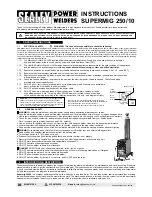
Declaration of Conformity
We, the sole importer into the UK, declare that the product listed below is in conformity with the following EEC standards and directives.
The construction file for this product is held by the Manufacturer and may be inspected on
request by contacting Jack Sealey Ltd
Models: SUPERMIG250/10
73.23/EEC
Low Voltage Directive (S.I. 1994/3260)
89/336/EEC
EMC Directive (S.I. 1992/2372 & Amendments).
Date 1st March 1998
Sealey Group,
Bury St. Edmunds,
Suffolk.
01284 757500
01284 703534
E-mail:
SUPERMIG 250-Job181-280198
IMPORTANT:
NO RESPONSIBILITY IS ACCEPTED FOR INCORRECT USE OF THIS EQUIPMENT.
WARRANTY:
GUARANTEE IS 12 MONTHS FROM PURCHASE DATE. PROOF OF PURCHASE WILL
BE REQUIRED FOR ANY CLAIM.
INFORMATION:
PLEASE CALL US FOR A COPY OF OUR LATEST CATALOGUE.
1. Power source stops
2. No weld current, fuse blowing in 13amp plug
3. No weld current
4. Feed motor not working, lamp is on
5. Wire does not feed, feed roller rotates
6. Wire feeds unevenly.
7. Unstable arc.
8. Porous weld
9. Electrode sticking in nozzle
10. Irregular weld head
11. Weld bead too narrow and raised
12. Weld bead too wide
13. Poor penetration
14. Excessive penetration
15. Fuse blowing
Overheating protection activated due to overload
Rectifier blown
Bad connection between clamp & workpiece
Break in earth lead
Break in torch lead
Fuse blown
Gear damaged or worn
Motor defective
Pressure roller improperly adjusted
Dirt, copper, dust, etc, have collection in torch liner
Gas cup (nozzle) defective also check tip
Deformed wire
Dirt, etc, in liner
Gas cup (nozzle) defective
Gas cup (nozzle) spattered
Feed roller groove clogged
Feed roller groove deformed
Pressure roller tension improper
Incorrect settings
Impurities in weld area
Worn or defective gas cup (nozzle)
No gas
Gas cup (nozzle) clogged
Draft blowing away shielding gas
Rusty or dirty joints
Torch too far from or at wrong angle to work
Gas leak
Worn or defective gas cup (nozzle)
Electrode deformed
Wire speed too slow
Torch incorrectly held
Wire weaving in weld pool
Weld current too high
Weld speed too low
Weld current too high
Weld speed too low
Arc too long
Weld current too high
Arc too long
Weld current too high
weld speed too slow
incorrect distance of torch to workpiece
Tension too great
Gas cup contact tip clogged
DEFECT
POSSIBLE CAUSE
REMEDY
(Numbers refer to chapter and item heading)
7. TROUBLESHOOTING
Protection automatically resets when transformer has cooled
(about 15 min).
Replace rectifier.
Clean or grind contact surface and weld area. (4.1),
Repair or replace earth lead.
Repair or replace torch.
Replace fuse 1.5 amp. (6.6).
Replace gears. (6.7).
Replace motor (Contact service agent).
Adjust tension.(3.4).
Clean the liner from the machine forward. Use compressed air.
If too much dirt, replace the liner. (see 6.6).
Replace gas cup (nozzle) and check tip. (6.3 & 6.4).
Check pressure roller tension and adjust it if necessary (3.4).
Clean the liner from the machine forward. Use compressed air.
Replace gas cup (nozzle) and check tip. (6.3 & 6.4).
Clean or replace gas cup (nozzle). and check tip. (6.3 & 6.4).
Clean feed roller. (6.7).
Replace feed roller. (6.7).
Adjust tension. (3.4).
Use recommended settings. (4.1.2).
Clean or grind weld area.
Replace gas cup (nozzle). (6.4).
Open gas cylinder, regulate gas flow.
Clean or replace gas cup (nozzle) and check tip. (6.3 & 6.4).
Screen off welding site or increase gas flow.
Clean or grind workpiece. (4.1).
The distance from gas cup to workpiece should be 8-10mm
and torch angle 60
0
.
Check hoses, connections and torch assembly. (see 6.2.).
Press the gas cup in correction position.
Replace gas cup (nozzle). (6.4).
Check pressure roller tension. (3.4).
See recommendations for wire speed. (see 4.2).
Use torch angle 60
0
. (Chapter 5).
Check pressure roller tension and adjust as needed. (3.4).
Increase voltage and wire speed. (4.2).
Move torch slower and weave a little more.
Decrease voltage and wire speed. (4.2).
Move torch faster and weave less.
Bring torch closer to workpiece.
Increase voltage and wire speed. (see 4.2.).
Bring torch closer to workpiece.
Decrease voltage and wire speed. (see 4.2.).
Move torch faster.
Torch distance should be 8-10mm.
Release tension. (3.4).
Clean gas cup and contact tip. (6.3 & 6.4).
J. Sealey.
Jack Sealey Ltd.
Sealey Power Welders.





